The Aerospace History Blog - Page 14

Post 062
Otto Brauer -
a famous early Luft Hansa Pilot
Sometimes there are strange coincidences: My grandfather, Willi Jack,
worked in the aviation industry, at Henschel and Messerschmitt. My
wife's grandfather, Hans Hahn, was an employee of Luft Hansa. Both
were enthusiastic about aviation.
The Hahn family was close friends with the well-known pilot Otto
Brauer and his permanent on-board technician and copilot Hans
Etzold. Brauer first flew in the airline's normal scheduled service and
then became the pilot of the huge Junkers G 38. The family photo
below shows Otto Brauer and Hans Etzold with the Luft Hansa
certificates, which were awarded to them on January 11, 1929 after
flying 500,000 kilometers. The photo was taken in the Hahn family's
apartment in Berlin-Kreuzberg, on Kottbusser Damm. Hans Hahn
shared his passion for photography with Otto Brauer. However, Hans
Hahn's photo album was burned when the house was hit by British
bombs during the war and the family and three children were buried for
over a day. I held Otto Brauer's photo albums in my hands in 1992 - but
more about that later.

Posted by Uwe W. Jack
Hans Hahn was an administrative
employee at Luft Hansa - and my wife's
grandfather. He worked at Tempelhof
Airport in the 1920s and 30s. Here he
is standing in front of a Junkers G 24.
(click to enlarge - the file may not be
modified - commercial use is
prohibited.)
To celebrate 500,000 kilometers of flying in the Hahn family's apartment in January 1929:
standing on the right is Otto Brauer, Hans Etzold on the left. Sitting from the right: grandparents
Hahn, the parents of Hans Etzold (?) and a friend and colleague from Luft Hansa of the Hahn
family.
(click to enlarge - the file may not be modified - commercial use is prohibited.)
Otto Brauer stood out everywhere because of his tall, bulky stature;
normally pilots were (and are) rather short. Born on October 16, 1897,
Brauer was very humorous and a gifted pilot. Since 1927 he had been
responsible for mult-engined aircraft at Luft Hansa. At Junkers, Brauer
supervised the design, construction and testing of the G 38. He carried
out the first flight of the Junkers G 38 D-2000 on November 6, 1929. At
the time it was the largest land passenger aircraft in the world. During
his flights with the second G 38 built, D-2500, later D-APIS, he always
takes care for the 34 passengers and was happy to explain to them
the technical features of the aircraft. The engines could be serviced in
flight. The wing was so thick that there were also seats with windows
in the wing close to the fuselage with a view in the flight direction.
On December 1, 1934, Brauer covered his millionth kilometer in
the air. On September 1, 1935, he became a first lieutenant in the
reserve in the newly formed Luftwaffe. At the inauguration of the
Norwegian airport in Stavanger in 1938, Brauer showed the G 38 in
front of the Norwegian king. During the war, Brauer flew his G 38 with
the Luftwaffe registration GF+GG as a transporter. In April 1940 he
transported Luftwaffe musicians to Oslo for the victory celebration. On
May 17, 1941, British aircraft destroyed his G 38 at Athens airfield.
The first of the two G 38s had crashed during a test flight in 1936.
I only found out about the Hahn family's relationship with Otto Brauer in
2020 through the photo shown here. The Luft Hansa pilot, who died in
1976, had already crossed my path twice.
I had close contact with the well-known aviation author Heinz J.
Nowarra from the 1980s onwards; he was a friend of Brauer. Nowarra
had worked at Junkers and met Brauer there in 1942. Nowarra offered
me collaboration on a biography of Otto Brauer. He could access
Brauer's photo albums with more than 1,000 historical aviation photos,
which now belong to the widow. We were both busy with other projects,
so no biography emerged.
I discovered the three thick Brauer photo albums at a flea market
in Berlin in 1992. I was thrilled by the numerous photos of early
passenger aircraft - but the price was less pleasing. The three albums
should cost a total of 8,000 German marks (around 4,000 euros). Two
years later I met the dealer again and asked about the albums. He sold
most of the photos individually and threw the rest away - a sad fate!

April 29, 1933: The Junkers G 38 was christened
“Generalfeldmarschall Hindenburg” in Tempelhof. Reich
President Hindenburg and Reichswehr Minister von
Blomberg go to the plane. Hermann Göring, Minister of
Aviation, follows. State Secretary Erhard Milch looks from
the background.
(click to enlarge - the file may not be modified - commercial
use is prohibited.)

Post 063
Looking for the correct color of a V-2 rocket
In April 2024, under the heading “The Last Secret of the V2,” the
German Museum in Munich published the project for an investigation
into the Aggregat A4 rocket (propaganda designation V-2) exhibited in
the museum. The rocket will soon be restored. Years of exhibition and
more recent construction work in the museum's aviation hall have left
minor damage to the rocket. Corrosion has also occurred in many
places.

Posted by Uwe W. Jack
A infrared camera is positioned near the electronic compartment of
the V-2 rocket in Munich. Scientists are trying to find traces of the
original painting.
The rocket was intended as a weapon and was not intended to have
a long lifespan. This special rocket was built in the tunnel of the
underground “Mittelbau” factory by concentration camp prisoners.
Captured by US troops at the end of the war, the A4 unit was brought
to the USA and given to the museum in Munich in 1955. Now
scientists are documenting the damage to the rocket and trying to
determine what paint the rocket originally had. The white color with
black lines was the paint for experimental rockets in the USA. Where
the white paint peels off, a green coating appears.
The Aggregat A4 (V-2) in Munich is
currently presented inside a
stairway. Visiters can walk up and
down to discover every inch of the
rocket.

Original painting instruction for the three tone camouflage pattern.
The three colors used are:
RLM 71 green (Luftwaffe color)
RAL 9003 white (Army color)
RAL 7028 brownish yellow (Army color)
(click to enlarge - the file may not be modified - commercial use is prohibited.)
This video still shows the painting of dark
green over all surfaces. Please note, that
over the long years the colors of the shots
have faded.
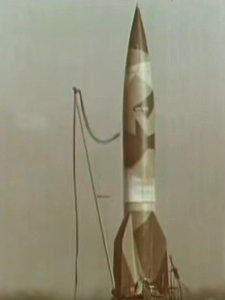
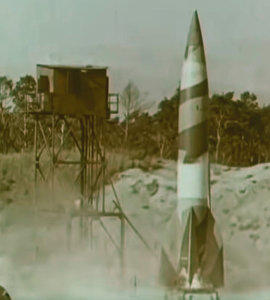
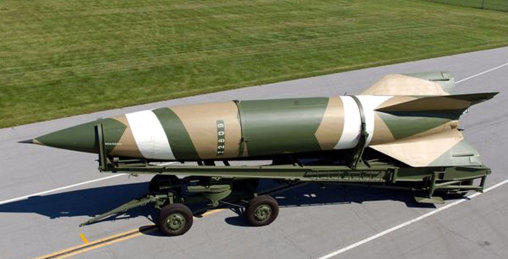

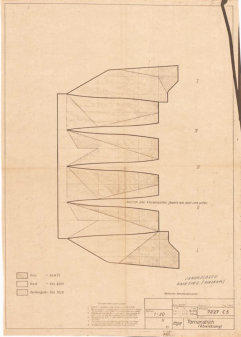
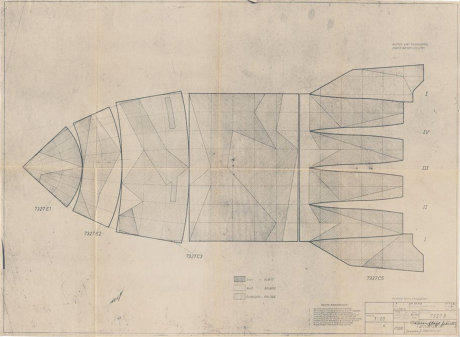

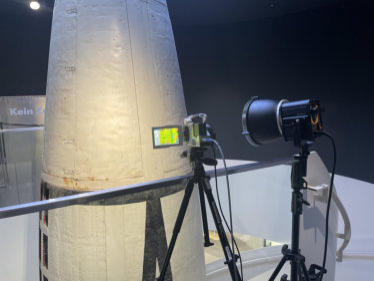

In Germany, the rockets for military use were initially painted dark
green over all surfaces. That's why they were jokingly called
"cucumbers” (Gurke). Later, the V-2s received a three-tone
camouflage paint scheme.
Using infrared photos, scientists are now trying to find out what the
rocket originally looked like. During the first attempts, no traces of
camouflage painting could be discovered.
Two video stills from test launches of Aggregat A4 rockets from the beaches near
Peenemunde at the Baltic Sea. The rockets carry the three-tone painting.

A V-2 with a “factory fresh” camouflage is exhibited in the Museum of the U.S. Air Force.
(click to enlarge - the file may not be modified - commercial use is prohibited.)

Original painting instruction for the
rockets tail.
(click to enlarge - the file may not be
modified - commercial use is prohibited.)





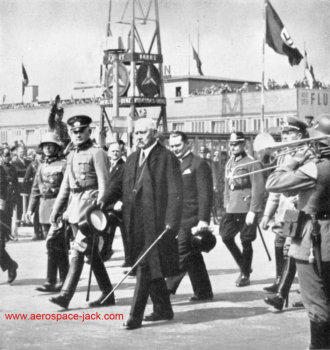


The Luft Hansa awards for 500,000 kilometers in the air.
(click to enlarge - the files may not be modified - commercial use is prohibited.)
Prototype of the Junkers G 38. The windows in the wings are clearly visible.
(click to enlarge - the files may not be modified - commercial use is prohibited.)
Otto Brauer then organized the testing and production of the four-engine
Ju 290 transporter at Junkers. He also became head of the Luftwaffe's
construction supervision department. As a major, Brauer also flew
transport missions in the TG4 transport squadron and possibly also
tested the Ju 290 as a missile carrier. In 1945, Otto Brauer was taken
prisoner by the Soviets, which lasted until 1948. After the war, Brauer
raved about the flight characteristics of the Junkers G 38. He had flown
various large aircraft, but none flew as stable as the G 38.
April 29, 1933: Hermann Göring speaks. Standing on the
right is Hans Etzold (with glasses) next to him -
unmistakably - Otto Brauer. Luft Hansa board member
Martin Wronsky is next to the speaker.
(click to enlarge - the file may not be modified - commercial
use is prohibited.)



Post 064
The Messerschmitt Me 163 will fly again!
What a surprise! Heinz-Dieter Sippel's presented at the AERO aviation
trade fair in Friedrichshafen on Lake Constance in April 2024 his replica
project. He has recreated a Messerschmitt Me 163 in its original size
using plastic composite construction. The special feature of this project
is that the "Me 163" has a jet engine.

Posted by Uwe W. Jack
Among all the modern aircraft at AERO 2024, the "Me 163" was a particular visitor magnet.
(click to enlarge - the file may not be modified - commercial use is prohibited.)
The replica is not powered by a rocket engine, but by an air-
breathing engine from JetCat. The P1000-Pro delivers a thrust of
1100 N at a weight of 11 kg. The aircraft is designed to take off in
tow behind a motorized aircraft. The turbine then gives the replica a
speed of up to 140 km/h in solo flight. With a maximum take-off
weight (MTOW) of 300 kg and an empty weight of 120 kg, the replica
is to be certified as an ultralight aircraft.

The egg-shaped area at the rear (on both
sides) is the air intake for the engine.
(click to enlarge - the file may not be
modified - commercial use is prohibited.)
Sippel was able to examine the original Me 163 at the RAF Museum
in Cosford. His replica took eight years to build. Stress tests and the
first flight of the new Me 163 are planned for 2024. The aircraft is
then to be flown at aviation events.
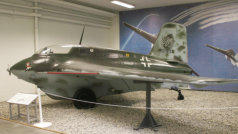


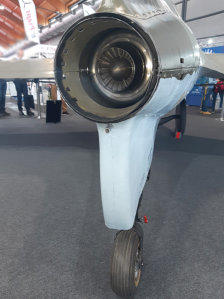



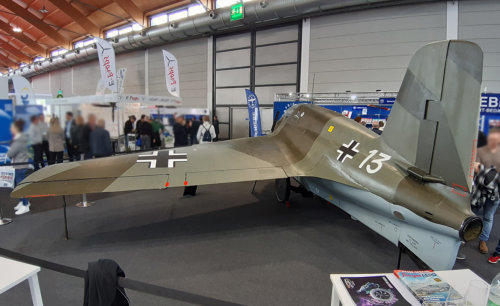
The jet engine in the tail.
(click to enlarge - the file may not be
modified - commercial use is prohibited.)
The mini jet engine JetCat P1000-Pro with
a thrust of 1000 N.
(click to enlarge - the file may not be
modified - commercial use is prohibited.)
The replica has a wheel for landing - the skid is only
simulated.
(click to enlarge - the file may not be modified -
commercial use is prohibited.)
Tecnical data of the original
Me 163 and the replica.
(click to enlarge - the file
may not be modified -
commercial use is
prohibited.)
Compare the original Me 163 from the
Luftwaffe museum Gatow with the replica.
(click to enlarge - the file may not be
modified - commercial use is prohibited.)
It was not easy to take photos without any visitor standing in front of the replica…
(click to enlarge - the file may not be modified - commercial use is prohibited.)











